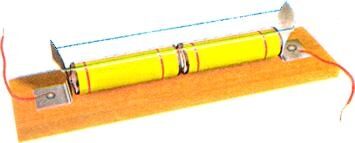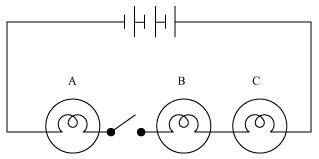Electric Current and its Effects
In the circuit shown in figure
(i) Would any of the bulbs glow when the switch is in the ‘OFF’ position?
(ii) What will be the order in which the bulbs A, B and C will glow when the switch is moved to the ‘ON’ position?
(i) No.
When the switch is in ‘OFF’ position, the current does not flow through the circuit. Hence, none of the bulbs will glow.
(ii) Bulbs will glow simultaneously.
When the switch is moved to the ‘ON’ position, then all the bulbs will glow at once. This is because they all are connected to the same battery and switch.
Sponsor Area
Some More Questions From Electric Current and its Effects Chapter
Mark ‘T’ if the statement is true and ‘F’ if it is false:
(a) To make a battery of two cells, the negative terminal of one cell is connected to the negative terminal of the other cell. (T/F)
(b) When the electric current through the fuse exceeds a certain limit, the fuse wire melts and breaks. (T/F)
(c) An electromagnet does not attract a piece of iron. (T/F)
(d) An electric bell has an electromagnet. (T/F)
Do you think an electromagnet can be used for separating plastic bags from a garbage heap? Explain.
An electrician is carrying out some repairs in your house. He wants to replace a fuse by a piece of wire. Would you agree? Give reasons for your response.
Zubeda made an electric circuit using a cell holder shown in Fig. 14.4, a switch and a bulb. When she put the switch in the ‘ON’ position, the bulb did not glow. Help Zubeda in identifying the possible defects in the circuit.

In the circuit shown in figure

(i) Would any of the bulbs glow when the switch is in the ‘OFF’ position?
(ii) What will be the order in which the bulbs A, B and C will glow when the switch is moved to the ‘ON’ position?
Mock Test Series
Sponsor Area
NCERT Book Store
NCERT Sample Papers
Sponsor Area